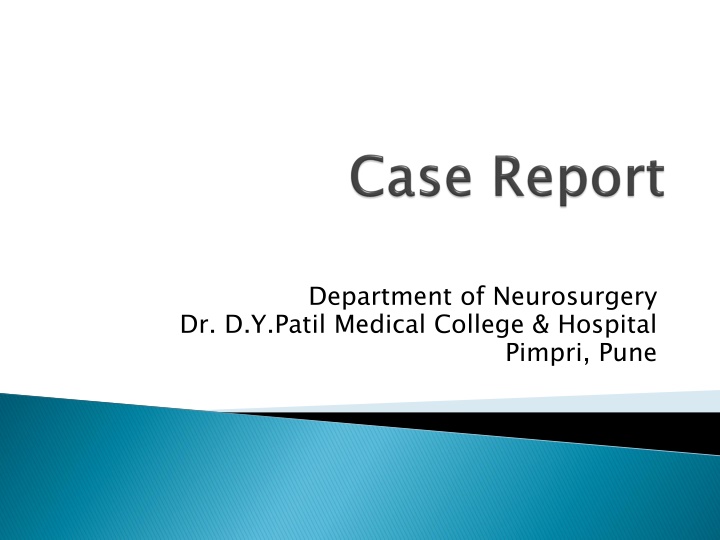
Intraventricular Cyst Excision: A Surgical Case Study
A 12-year-old female presented with headaches, vertigo, and vomiting, leading to the discovery of a large cystic intraventricular mass in the left lateral ventricle. Endoscopic exploration and complete excision of the cyst were performed, achieving a successful outcome.
Download Presentation

Please find below an Image/Link to download the presentation.
The content on the website is provided AS IS for your information and personal use only. It may not be sold, licensed, or shared on other websites without obtaining consent from the author. If you encounter any issues during the download, it is possible that the publisher has removed the file from their server.
You are allowed to download the files provided on this website for personal or commercial use, subject to the condition that they are used lawfully. All files are the property of their respective owners.
The content on the website is provided AS IS for your information and personal use only. It may not be sold, licensed, or shared on other websites without obtaining consent from the author.
E N D
Presentation Transcript
Department of Neurosurgery Dr. D.Y.Patil Medical College & Hospital Pimpri, Pune
12year , Female c/o Headache * 2 weeks Worsened on forward bending Associated with vertigo and vomiting No history of fever, seizures or visual symptoms
Patient conscious, oriented and obeying commands Pupils BERL Fundus suggestive of early papillodema Perimetry showed generalized scotomatous points
Large cystic Intraventricular mass in the frontal horn of the left lateral ventricle measuring 4*5*3.2 cm Hypointense on T1 Hyperintense on T2 and FLAIR No contrast enhancement seen in the lesion
Small solid nodule of 7*6mm seen in the periphery of the lesion along posterior aspect Lesion caused displacement of septum pellucidum to the right and dilatation of both lateral ventricles with mild periventricular ooze D/D: ependymal cyst, arachnoid cyst, choroid plexus cyst, colloid cyst.
Endoscopic exploration with excision of cyst Intraop findings: Large cyst in the lateral ventricle with a gritty surface and a frond like movement within the ventricle On aspiration: Clear CSF like fluid Cyst was removed completely and sent for HPE
3rdventricle was inspected for any remnants of the cyst. Ventricle irrigated with RL solution.
Complete excision of the cyst with septum pellucidum attaining its normal midline position
HPE suggestive of Neurocysticercosis Post op period uneventful Patient discharged on Albendazole for 1 month Improvement in post operative perimetry
NCC is uncommon in childhood due to long incubation period of the disease which ranges from several months to 30 years. NCC is divided into parenchymal and extraparenchymal forms Extraparenchymal includes a) Intraventricular b) Subarachnoid c) Occasional spinal
<17 years of age constitute 0.827.5% of diagnosed cases of NCC The cysts reach the ventricular system through the choroid plexus More frequently found in the fourth ventricle, likely due to the gravitational forces which favor migration from supratentorial ventricles or may directly enter through the choroid plexus.
Cyst attached to the ventricular wall involutes and eventually resolve Cysts which are not attached may migrate and block the cerebrospinal flow causing obstructive hydrocephalus.
Clinical features of IVNCC with hydrocephalus: a) Headache b) Nausea, vomiting c) Altered sensorium d) Papillodema or e) Present infrequently with features of Brun s syndrome. Mechanism of hydrocephalus is either ventricular obstruction or arachnoiditis.
First described in 1902 Characterized by sudden onset of severe headaches, vomiting associated to a vestibular syndrome triggered by an abrupt movement of the head.
Mobile deformable intraventricular mass leading to an episodic obstructive hydrocephalus from an intermittent or positional CSF obstruction with elevation of ICP (ball valve mechanism).
Diagnosis of NCC includes Systematic evaluation of clinical features a) b) Neuroimaging c) Serology(has limited role because of low sensitivity and specificity)
Identification of a scolex in a cystic lesion is the pathognomonic radiological finding. Scolices appear as rounded or elongated bright nodules within the cyst cavity. NCCT is sensitive for calcified and parenchymal lesions, but is insensitive for extraparenchymal disease. MRI is preferred diagnostic test for extraparenchymal NCC
Antiparasitic drugs a) b) Surgery Symptomatic medications. c)
Corticosteroids represent the primary form of therapy for meningitis, cysticercal encephalitis and angitis. Praziquantel and albendazole have been used with success to treat NCC They destroy 60%- 80% of parenchymal brain cysticerci after a course. The most accepted regimens of cysticidal drugs are albendazole, 15 mg/kg per day for 1 week, and praziquantel, 50 mg/kg per day for 2 weeks.
Medical management alone is not recommended because of the limited effectiveness of albendazole and praziquentel. Principles of surgery include managing hydrocephalus and removal of the cyst. Neuroendoscopy is preferred over microsurgery and ventriculoperitoneal shunt.
Even in the emergent case of Bruns syndrome, neuroendoscopy has been proven both diagnostic and curative, as endoscopic third ventriculostomy (ETV) or septum pellucidotomy can be done to prevent delayed hydrocephalus in addition to cyst removal. Under Endoscopic visualization, cysticerci appear as a full moon which is considered pathognomonic for IVNCC.
According to literature intraoperative cyst rupture causing post operative ventriculitis is rare. In our case cyst rupture occurred intraoperatively however patient did not have postoperative ventriculitis.
Intraventricular NCC presenting as Bruns syndrome is very rare. Timely intervention can prevent mortality. Neuroendoscopy is a viable option.






















